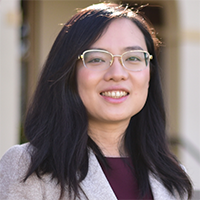2nd ACM Workshop on Device-Free Human Sensing
A Buildsys 2020 Workshop
SubmissionA Buildsys 2020 Workshop
SubmissionAll times are Eastern Standard Time.
Shijia Pan
Andreas Reinhardt(TU Clausthal) and Christoph Klemenjak (University of Klagenfurt)
Roshan Shyamsunder, Yash Patel and Aleksandar Kuzmanovic (Northwestern University)
Shijia Pan (University of California Merced) and Phuc Nguyen (University of Texas at Arlington)
Mayank Gupta, Lingjun Chen, Denny Yu, Vaneet Aggarwal (Purdue University)

Dr. Shijia Pan Assistant Professor of Computer Science and Engineering University of California, Merced
Sense for Less: Physical-Informed Adaptive Cyber-Physical Systems for Device-Free Human Monitoring
The number of everyday smart devices is projected to grow to the billions in the coming decade, which enables various smart building applications. These applications, especially in-home long-term occupant monitoring, rely on the emerging device-free human sensing techniques. From the system perspective, general problems faced by existing technologies (vision-, sound-, RF-, and load-based methods) are the tradeoff between the information acquisition resolution and the sensing requirements (e.g., line-of-sight, high deployment density, calibration). We introduce an alternative non-intrusive indoor human information acquisition through ambient structural vibration, or ‘Structures as Sensors’. People’s interaction with ambient structures (e.g., floor, table, door) induces structures to vibrate. By capturing and analyzing the vibration response of structures, we can indirectly infer fine-grained (action-level) information about the people and their actions. However, due to the complexity of the physical world, sensing data distributions can change significantly under different sensing conditions. Therefore, from the data perspective, accurate information learning through pure data-driven approaches requires a large amount of labeled data, which is costly and difficult to obtain in real-world applications. We address these challenges by combining physical and data-driven knowledge to reduce the label data needed via multiple approaches.
Dr. Shijia Pan is an Assistant Professor at University of California Merced. She received her bachelor’s degree in Computer Science and Technology from the University of Science and Technology of China and her Ph.D. degree in Electrical and Computer Engineering at Carnegie Mellon University. Her research interests include cyber-physical systems, Internet-of-Things (IoT), and ubiquitous computing. She worked in multiple disciplines and focused on indoor human information acquisition through ambient sensing. She has published in both top-tier Computer Science ACM/IEEE conferences and high-impact Civil Engineering journals. She received Rising Stars in EECS, Nick G. Vlahakis Graduate Fellowship, Google Anita Borg Scholarship, Best Paper Awards (IoTDI, ASME SHM/NDE, HASCA), Best Poster Awards (SenSys, IPSN), Best Demo Award (Ubicomp, BuildSys), Best Presentation Award (SenSys Doctoral Colloquium), and Audience Choice Award (BuildSys) from ACM/IEEE conferences.